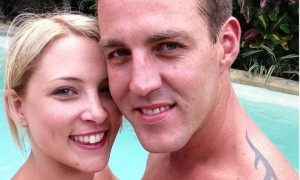heroes and tests: problematic language in rossington-schroder inquiry

Image via Guardian Australia / Facebook
On the May 8, 2013, at 8:48 pm, Paul Rossington leapt from his cabin balcony on the Carnival Spirit cruise liner into the Tasman sea, 19 metres below. He did not survive. Just hours before the fatal fall, Mr Rossington was seen arguing with fiancée, Ms Kristen Schroder, with whom he reportedly had a ‘volatile relationship’ as described by Channel Nine news.
Around 9pm that night, infrared CCTV footage showed a figure, presumably Ms Schroder, climbing over the balcony of their cabin before apparently slipping, then falling after clinging to the wooden railing for about four seconds. She tumbled more than six metres, struck the railing of a lower deck, and then somersaulted a further 12 metres into the sea below.
For following his girlfriend of ten months off the balcony and to their deaths, Paul Rossington has been posthumously recommended for Australia’s highest honour for bravery, the Cross of Valour. The officer in charge of the case, Detective Sergeant Michael O’Keefe stated ‘he must have known that jumping out would most likely end with him losing his life,’ and therefore decided to nominate Mr Rossington for this lofty honour.
Since the announcement, news sources around Australia have all weighed in on the event, with many claiming that Schroder was ‘testing’ her ‘heroic’ fiancée before she fell. What is problematic around the reporting of this incident is the formulaic light used to illuminate the two central figures. Rossington, a paramedic (it’s never failed to be mentioned), is painted eternally as the ‘hero’, with the advocate assisting the Coroner, Erika Mulligan, stating that Mr Rossington ‘acted on instinct in attempting to save her’. ‘He has not thought about his safety at all… that is certainly an act of bravery,’ Ms Mulligan said.
The events that unfolded were indeed tragic, however it is difficult to swallow the idea that not thinking about your safety whatsoever is a heroic deed. Ms Schroder did not take her own safety into account during the feud with her partner, however she is cast in an entirely different light. If not the eternal damsel in distress, she is depicted as ‘testing’ Rossington, the infernal woman baiting her man and causing all the grief because hey, she’s probably excessively emotional or has menstrual cramps. What does this say about how the Australian media treats victims of volatile relationships, particularly women?
The faster we start to see the female casualties of tragic circumstances in a more accurate light, the closer we will be to busting mythological projections of feminine frailty, and having a better understanding of their suffering. As for their male counterparts, there is a similar – and just as dangerous – proliferation of the idea that men are the eternal heroes in perilous times, and this is something that is increasingly prevalent in the media.
Many of us model and evaluate our behavior on the basis of our cultural heroes; our choice of heroes has a fundamental effect on the kind of social awareness we develop. Everyone needs their heroes – someone to help inspire dreams and shape goals. A boy or girl who grows up watching a cartoon G.I. Joe subdue and pin down a bikini-clad temptress may develop a different self-concept than one who spends his or her time enthralled by the biographies of historical and contemporary heroes and heroines like Jane Addams, Martin Luther King Jr, Simon Bolivar or Eleanor Roosevelt. Indeed, we receive the heroes we deserve, and more often than not, they’re muscle-bound supermen with a penchant for lusty (silent) women.
Channel Nine news describes the events of May 2013 as ‘a profound human tragedy’, and they certainly were. What could have come from this devastating incident was something that flew in the face of societal conceptions of the hero / temptress trope, celebrating the autonomy and identity of those involved, and not fetishising male acts of impudence to fabricate a headline-worthy story. When the coroner involved in the Rossington-Schroder case said ‘paradoxically, what they had struggled to achieve in life – loving unity – they perhaps managed in their last actions alive,’ he unwittingly made a perfect summarisation of our media spin of tragic events. When you can squeeze romance into a freak accident causing the deaths of two young Australians, you could be selling it just right.


Apart from the hero language around the inquiry, what struck me was that he contributed to both their deaths by jumping in after her instead of raising the alarm.